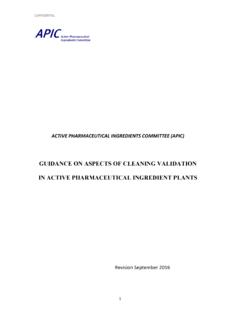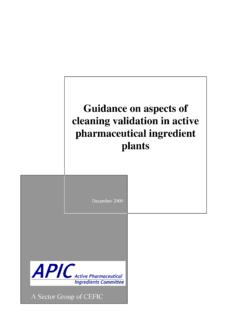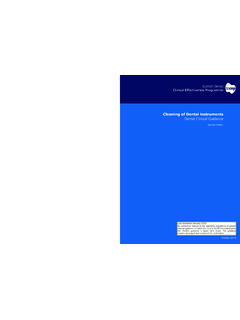Transcription of Annex 4 Supplementary guidelines on good …
1 107 World Health OrganizationWHO Technical Report Series, No. 937, 2006 Annex 4 Supplementary guidelines on good manufacturing practices: validation1. Introduction 2. Scope 3. Glossary 4. Relationship between validation and qualifi cation 5. validation Approaches to validation Scope of validation 6. Qualifi cation 7. Calibration and verifi cation 8.
2 validation master plan 9. Qualifi cation and validation protocols 10. Qualifi cation and validation reports 11. Qualifi cation stages 12. Change control 13. Personnel ReferencesAppendix 1 validation of heating, ventilation and air-conditioning systemsAppendix 2 validation of water systems for pharmaceutical useAppendix 3 Cleaning validationAppendix 4 Analytical method validation Appendix 5 validation of computerized systems Appendix 6 Qualifi cation of systems and equipment Appendix 7 Non-sterile process validation 16:12 16:12:531081. IntroductionValidation is an essential part of good manufacturing practices (GMP).
3 It is, therefore, an element of the quality assurance programme associated with a particular product or process. The basic principles of quality assurance have as their goal the production of products that are fi t for their intended use. These principles are as follows: Quality, safety and effi cacy must be designed and built into the product. Quality cannot be inspected or tested into the product. Each critical step of the manufacturing process must be validated. Other steps in the process must be under control to maximize the probability that the fi nished product consistently and predictably meets all quality and design specifi of processes and systems is fundamental to achieving these goals. It is by design and validation that a manufacturer can establish confi dence that the manufactured products will consistently meet their product specifi associated with validation includes: standard operating procedures (SOPs) specifi cations validation master plan (VMP) qualifi cation protocols and reports validation protocols and implementation of validation work requires considerable resources such as: Time: generally validation work is subject to rigorous time schedules.
4 Financial: validation often requires the time of specialized personnel and expensive technology. Human: validation requires the collaboration of experts from various dis-ciplines ( a multidisciplinary team, comprising quality assurance, en-gineering, manufacturing and other disciplines, depending on the product and process to be validated).These guidelines aim to give guidance to inspectors of pharmaceutical manu-facturing facilities and manufacturers of pharmaceutical products on the requirements for validation . The main part covers the general principles of validation and qualifi cation. In addition to the main part, appendices on vali-dation and qualifi cation ( cleaning, computer and computerized systems, equipment, utilities and systems, and analytical methods) are These guidelines focus mainly on the overall concept of validation and are intended as a basic guide for use by GMP inspectors and 16:12 16:12:53109turers.
5 It is not the intention to be prescriptive in specifi c validation require-ments. This document serves as general guidance only, and the principles may be considered useful in its application in the manufacture and control of active pharmaceutical ingredients (APIs) and fi nished pharmaceutical products. validation of specifi c processes and products, for example in ster-ile product manufacture, requires much more consideration and a detailed approach that is beyond the scope of this There are many factors affecting the different types of validation and it is, therefore, not intended to defi ne and address all aspects related to one particular type of validation Manufacturers should plan validation in a manner that will ensure regulatory compliance and ensuring that product quality, safety and consis-tency are not The general text in the main part of these guidelines may be appli-cable to validation and qualifi cation of premises, equipment, utilities and systems, and processes and procedures.
6 More specifi c principles of quali-fi cation and validation are addressed in the appendices. Semi-automatic or fully automatic clean-in-place (CIP) systems and other special cases should be treated GlossaryThe defi nitions given below apply to the terms used in these guidelines . They may have different meanings in other set of operations that establish, under specifi ed conditions, the relation-ship between values indicated by an instrument or system for measuring (for example, weight, temperature and pH), recording, and controlling, or the values represented by a material measure, and the corresponding known values of a reference standard. Limits for acceptance of the results of mea-suring should be validationDocumented evidence which provides a high degree of assurance that a computerized system analyses, controls and records data correctly and that data processing complies with predetermined specifi setting up, adjustment and testing of equipment or a system to ensure that it meets all the requirements, as specifi ed in the user requirement speci-fi cation, and capacities as specifi ed by the designer or developer.
7 Commis-sioning is carried out before qualifi cation and 16:12 16:12:53110concurrent validationValidation carried out during routine production of products intended for validationDocumented evidence to establish that cleaning procedures are remov-ing residues to predetermined levels of acceptability, taking into con-sideration factors such as batch size, dosing, toxicology and equipment qualifi cation (DQ)Documented evidence that the premises, supporting systems, utilities, equipment and processes have been designed in accordance with the re-quirements of engineering practices (GEP)Established engineering methods and standards that are applied throughout the project life-cycle to deliver appropriate, cost-effective qualifi cation (IQ)The performance of tests to ensure that the installations (such as machines, measuring devices, utilities and manufacturing areas)
8 Used in a manufactur-ing process are appropriately selected and correctly installed and operate in accordance with established specifi qualifi cation (OQ)Documented verifi cation that the system or subsystem performs as intended over all anticipated operating qualifi cation (PQ)Documented verifi cation that the equipment or system operates consistently and gives reproducibility within defi ned specifi cations and parameters for prolonged periods. (In the context of systems, the term process validation may also be used.)process validationDocumented evidence which provides a high degree of assurance that a specifi c process will consistently result in a product that meets its predeter-mined specifi cations and quality validationValidation carried out during the development stage on the basis of a risk analysis of the production process, which is broken down into individual steps; these are then evaluated on the basis of past experience to determine whether they may lead to critical 16:12 16:12:53111qualifi cationAction of proving and documenting that any premises, systems and equip-ment are properly installed, and/or work correctly and lead to the expected results.
9 Qualifi cation is often a part (the initial stage) of validation , but the individual qualifi cation steps alone do not constitute process validationInvolves the evaluation of past experience of production on the condition that composition, procedures, and equipment remain validation of an approved process (or a part thereof) to ensure continued compliance with established operating procedure (SOP)An authorized written procedure giving instructions for performing opera-tions not necessarily specifi c to a given product or material but of a more general nature ( equipment operation, maintenance and cleaning; vali-dation; cleaning of premises and environmental control; sampling and in-spection). Certain SOPs may be used to supplement product-specifi c master batch production of proving and documenting that any process, procedure or method actually and consistently leads to the expected protocol (or plan) (VP)A document describing the activities to be performed in a validation , in-cluding the acceptance criteria for the approval of a manufacturing process or a part thereof for routine report (VR)A document in which the records, results and evaluation of a completed validation programme are assembled and summarized.
10 It may also contain proposals for the improvement of processes and/or master plan (VMP)The VMP is a high-level document that establishes an umbrella validation plan for the entire project and summarizes the manufacturer s overall phi-losophy and approach, to be used for establishing performance adequacy. It provides information on the manufacturer s validation work programme and defi nes details of and timescales for the validation work to be performed, including a statement of the responsibilities of those implementing the 16:12 16:12:53112verifi cationThe application of methods, procedures, tests and other evaluations, in ad-dition to monitoring, to determine compliance with the GMP caseA condition or set of conditions encompassing the upper and lower processing limits for operating parameters and circumstances, within SOPs, which pose the greatest chance of product or process failure when compared to ideal con-ditions.















